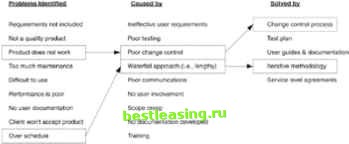

 |
 |

|
Промышленный лизинг
Методички
Status of Projects Today Across all industries whether IT or construction we are encountering many of the same problems time and time again, irrespective of geographic location. I have heard project managers in China, Brazil, Amsterdam, and Munich complain bitterly about similar issues on their projects. Problems such as cost and schedule overruns, poor sponsorship, no user involvement, and many other problems are encountered daily. These project managers either dont use their project methodologies effectively or dont use them at all. Project management is not simple; our primary role is to resolve or eliminate daily challenges. We now examine some of the universal challenges facing project managers, which are listed in Table 1.2. Table 1.2: Challenging project issues
Why do Projects Fail? One of the best project management oracles of all time Dr. J. Davidson Frame states that projects fail mainly because of two reasons: (1) a failure of estimation and (2) a failure of implementation. The following are reasons projects fail: Initial cost and schedule estimates are not revised when more information becomes available as the project progresses. Plans are not used correctly or used to guide the project forward. Project managers are not trained to acquire the necessary skill base; subsequently, the same mistakes are made repeatedly. The theory of project management is not put into practice. This point can be seen in the attitude of many managers who view theory as a waste of time yet time is found to repair errors later. Isnt that a sure sign of the wrong approach? The project scope changes. The incorrect project methodology is used. Requirements have major changes. Communications are poor. Testing and/or inspections are poorly done. Figure 1.4 shows familiar issues that cause problems on projects. However, any problem can be resolved by carefully drawing a problem matrix. If we have a project that is over schedule, we can follow this through on the matrix and see that it was caused by a waterfall approach. The solution to this problem is selecting an iterative methodology.  Figure 1.4: Problem resolution and fault-finding technique. Examining the Need for Methodologies Today, projects require much tighter integration and innovativeness than what we have seen during the past decade; this alone necessitates the use of more creative ways to design, build, test, and deploy products and services. A manager can no longer create a project schedule by filling in one or two templates. Companies require more out of their projects than ever before. One way to achieve a more efficient result is to adopt newer, swifter, and lighter project methodologies. Gone are the days of using a bureaucratic life-cycle approach, unless you have a very simple project that requires serious coordination and control. Table 1.3 shows us that project managers and executives have to be innovative and creative if they want to resolve historical problems. Table 1.3: Drivers for using methodologies
1 2 3 4 5 6 [ 7 ] 8 9 10 11 12 13 14 15 16 17 18 19 20 21 22 23 24 25 26 27 28 29 30 31 32 33 34 35 36 37 38 39 40 41 42 43 44 45 46 47 48 49 50 51 52 53 54 55 56 57 58 59 60 61 62 63 64 65 66 67 68 69 70 71 72 73 74 75 76 77 78 79 80 81 82 83 84 85 86 87 88 89 90 91 92 93 94 95 96 97 98 99 100 101 |